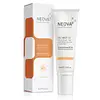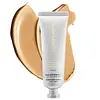What's inside
What's inside
 Key Ingredients
Key Ingredients

 Benefits
Benefits

 Concerns
Concerns

 Ingredients Side-by-side
Ingredients Side-by-side

Ethylhexyl Methoxycinnamate 3%
UV AbsorberTitanium Dioxide 3%
Cosmetic ColorantZinc Oxide 9%
Cosmetic ColorantAlumina
AbrasiveButylene Glycol
HumectantCitric Acid
BufferingPlankton Extract
Skin ConditioningCyclopentasiloxane
EmollientDimethicone
EmollientDimethicone/PEG-10/15 Crosspolymer
Ergothioneine
AntioxidantHdi/Trimethylol Hexyllactone Crosspolymer
Iodopropynyl Butylcarbamate
PreservativeIron Oxides
Lauryl PEG-9 Polydimethylsiloxyethyl Dimethicone
Skin ConditioningLecithin
EmollientMethicone
EmollientMicrococcus Lysate
Skin ConditioningOctyldodecyl Neopentanoate
EmollientPhenoxyethanol
PreservativeWater
Skin ConditioningSilica
AbrasiveSodium Chloride
MaskingSodium Hydroxide
BufferingTriethoxycaprylylsilane
Ethylhexyl Methoxycinnamate 3%, Titanium Dioxide 3%, Zinc Oxide 9%, Alumina, Butylene Glycol, Citric Acid, Plankton Extract, Cyclopentasiloxane, Dimethicone, Dimethicone/PEG-10/15 Crosspolymer, Ergothioneine, Hdi/Trimethylol Hexyllactone Crosspolymer, Iodopropynyl Butylcarbamate, Iron Oxides, Lauryl PEG-9 Polydimethylsiloxyethyl Dimethicone, Lecithin, Methicone, Micrococcus Lysate, Octyldodecyl Neopentanoate, Phenoxyethanol, Water, Silica, Sodium Chloride, Sodium Hydroxide, Triethoxycaprylylsilane
Zinc Oxide 14.2%
Cosmetic ColorantWater
Skin ConditioningCaprylic/Capric Triglyceride
MaskingNiacinamide
SmoothingButyloctyl Salicylate
Skin ConditioningPropanediol
SolventSqualane
EmollientAloe Barbadensis Leaf Juice
Skin Conditioning1,2-Hexanediol
Skin ConditioningSodium Acrylate/Sodium Acryloyldimethyl Taurate Copolymer
Emulsion StabilisingCetyl Alcohol
EmollientGlycol Stearate
EmollientHydroxyacetophenone
AntioxidantGlycerin
HumectantHelianthus Annuus Seed Oil
EmollientGlyceryl Stearate
EmollientLecithin
EmollientIsostearic Acid
CleansingPolyglyceryl-3 Polyricinoleate
EmulsifyingPolyhydroxystearic Acid
EmulsifyingVaccinium Vitis-Idaea Fruit Extract
AntioxidantIsohexadecane
EmollientXanthan Gum
EmulsifyingPolysorbate 80
EmulsifyingSorbitan Oleate
EmulsifyingPhenoxyethanol
PreservativeJojoba Esters
EmollientCitric Acid
BufferingGluconolactone
Skin ConditioningPlankton Extract
Skin ConditioningAlumina
AbrasiveSodium Benzoate
MaskingPotassium Sorbate
PreservativeSilica
AbrasiveCalcium Gluconate
HumectantCI 77891
Cosmetic ColorantIron Oxides
Zinc Oxide 14.2%, Water, Caprylic/Capric Triglyceride, Niacinamide, Butyloctyl Salicylate, Propanediol, Squalane, Aloe Barbadensis Leaf Juice, 1,2-Hexanediol, Sodium Acrylate/Sodium Acryloyldimethyl Taurate Copolymer, Cetyl Alcohol, Glycol Stearate, Hydroxyacetophenone, Glycerin, Helianthus Annuus Seed Oil, Glyceryl Stearate, Lecithin, Isostearic Acid, Polyglyceryl-3 Polyricinoleate, Polyhydroxystearic Acid, Vaccinium Vitis-Idaea Fruit Extract, Isohexadecane, Xanthan Gum, Polysorbate 80, Sorbitan Oleate, Phenoxyethanol, Jojoba Esters, Citric Acid, Gluconolactone, Plankton Extract, Alumina, Sodium Benzoate, Potassium Sorbate, Silica, Calcium Gluconate, CI 77891, Iron Oxides
Ingredients Explained
These ingredients are found in both products.
Ingredients higher up in an ingredient list are typically present in a larger amount.
Alumina is another name for the compound aluminum oxide. It is a white powder used as a thickener, absorbent, and abrasive.
As an absorbent, alumina can give a mattifying effect. It is used in mineral sunscreens to help coat nano-sized filters, such as titanium dioxide. By increasing the size of the UV filters, these ingredients stay on the skin for a longer time. By coating small sized ingredients, alumina helps thicken a product.
Alumina may be used as an abrasive, or exfoliant.
Alumina is naturally occurring in the mineral corundum. Certain varieties of corundum create rubies and sapphires. Corundum is also the crystalline form of alumina.
Learn more about AluminaCitric Acid is an alpha hydroxy acid (AHA) naturally found in citrus fruits like oranges, lemons, and limes.
Like other AHAs, citric acid can exfoliate skin by breaking down the bonds that hold dead skin cells together. This helps reveal smoother and brighter skin underneath.
However, this exfoliating effect only happens at high concentrations (20%) which can be hard to find in cosmetic products.
Due to this, citric acid is usually included in small amounts as a pH adjuster. This helps keep products slightly more acidic and compatible with skin's natural pH.
In skincare formulas, citric acid can:
While it can provide some skin benefits, research shows lactic acid and glycolic acid are generally more effective and less irritating exfoliants.
Most citric acid used in skincare today is made by fermenting sugars (usually from molasses). This synthetic version is identical to the natural citrus form but easier to stabilize and use in formulations.
Read more about some other popular AHA's here:
Learn more about Citric AcidLecithin is a term for a group of substances found in the cell membranes of plants, animals, and humans. They are made up of mixture of phospholipids.
This ingredient has emollient and emulsifying properties.
As an emollient, lecithen helps soften the skin and creates a barrier to keep moisture in.
As an emulsifier, it also helps prevent water and oil ingredients from separating. Lecithin can also help ingredients be better absorbed by the skin.
This is because the phospholipids in lecithin produce liposomes. Liposomes help other ingredients get through the skin barrier.
Depending on the source of this ingredient, lecithin may not be fungal acne safe. This is because some sources of lecithin come from soybean oil, which may feed the malassezia yeast that feeds fungal acne.
We recommend reaching out to the brand you are purchasing from to inquire about the source of their lecithin.
Some other names for this ingredient include soy lecithin and deoiled soy lecithin.
Learn more about LecithinPhenoxyethanol is a preservative that has germicide, antimicrobial, and aromatic properties. Studies show that phenoxyethanol can prevent microbial growth. By itself, it has a scent that is similar to that of a rose.
It's often used in formulations along with Caprylyl Glycol to preserve the shelf life of products.
We don't have a description for Plankton Extract yet.
Silica, also known as silicon dioxide, is a naturally occurring mineral. It is used as a fine, spherical, and porous powder in cosmetics.
Though it has exfoliant properties, the function of silica varies depending on the product.
The unique structure of silica enhances the spreadability and adds smoothness, making it a great texture enhancer.
It is also used as an active carrier, emulsifier, and mattifier due to its ability to absorb excess oil.
In some products, tiny microneedles called spicules are made from silica or hydrolyzed sponge. When you rub them in, they lightly polish away dead skin layers and enhance the penetration of active ingredients.
Learn more about SilicaWater. It's the most common cosmetic ingredient of all. You'll usually see it at the top of ingredient lists, meaning that it makes up the largest part of the product.
So why is it so popular? Water most often acts as a solvent - this means that it helps dissolve other ingredients into the formulation.
You'll also recognize water as that liquid we all need to stay alive. If you see this, drink a glass of water. Stay hydrated!
Learn more about WaterZinc Oxide is a mineral broad-spectrum UV filter; it is the broadest UVA and UVB reflector approved by the FDA. It also has skin protectant and skin soothing properties.
Zinc oxide is one of the most effective broad-spectrum UV filters. It protects against UVB, UVAII, and UVAI. In comparison to its counterpart titanium dioxide, zinc oxide provides uniform and extended UVA protection.
Another great benefit? This ingredient is highly photostable so it won't degrade easily under sunlight.
A common myth is that mineral UV filters are widely believed to primarily reflect UV light.
However, modern research shows titanium dioxide absorbs UV radiation like chemical filters (~95% absorption & 5% reflection).
Zinc oxide has great skin soothing properties so you'll likely find this in sunscreens formulated for sensitive skin or babies/children. It is unlikely to cause "eye sting" like other sunscreen ingredients.
Regulatory agencies consider zinc oxide to be non-toxic and safe. It has also been shown to not penetrate the skin.
Unfortunately, this ingredient does leave a visible white cast. This is why mineral sunscreens are often less cosmetically elegant than chemical or hybrid ones.
In cosmetics, zinc oxide can be found in both non-nano and nano-sized forms. The nano version is used to reduce white cast and improve the texture of sunscreen formulas.
There are ongoing concerns surrounding nano-zinc oxide's impact on marine ecosystems and whether it can be absorbed into skin.
Regarding marine ecosystems and coral reefs, there is no conclusive evidence that any form of zinc oxide (or any other sunscreen ingredients) will cause harm. The science is still developing but many consumers are keeping a close eye on this issue.
Please note, many destinations have reef-safety sunscreen rules. For instance, the U.S. Virgin Islands advises all visitors to use non-nano mineral sunscreens.
There has also been some stir about whether micronized or nano zinc oxide has potential photoxicity and absorption through the skin/lungs.
An in-vitro (done in a test tube or petri dish) study demonstrated micronized zinc oxide to have potential phototoxicity. There's no need to fret; the EU Commission's Scientific Committee on Consumer Safety has stated, "The relevance of these findings needs to be clarified by appropriate investigations in vivo." Or in other words, further studies done on living organisms are needed to prove this.
Current research shows zinc oxide nanoparticles do not penetrate intact or sunburned skin. They either remain on the surface or in the outermost layer of dead skin (stratum corneum).
Zinc oxide is one of only two classified mineral UV filters with titanium dioxide being the other one.
Fun fact: Zinc has been used throughout history as an ingredient in paint and medicine. An Indian text from 500BC is believed to list zinc oxide as a salve for open wound. The Ancient Greek physician Dioscorides has also mentioned the use of zinc as an ointment in 1AD.
Learn more about Zinc OxideThis ingredient is a combination of red, black, and yellow iron oxide pigments. This combination of colors is usually found in foundation, because it results in a "skin" color.